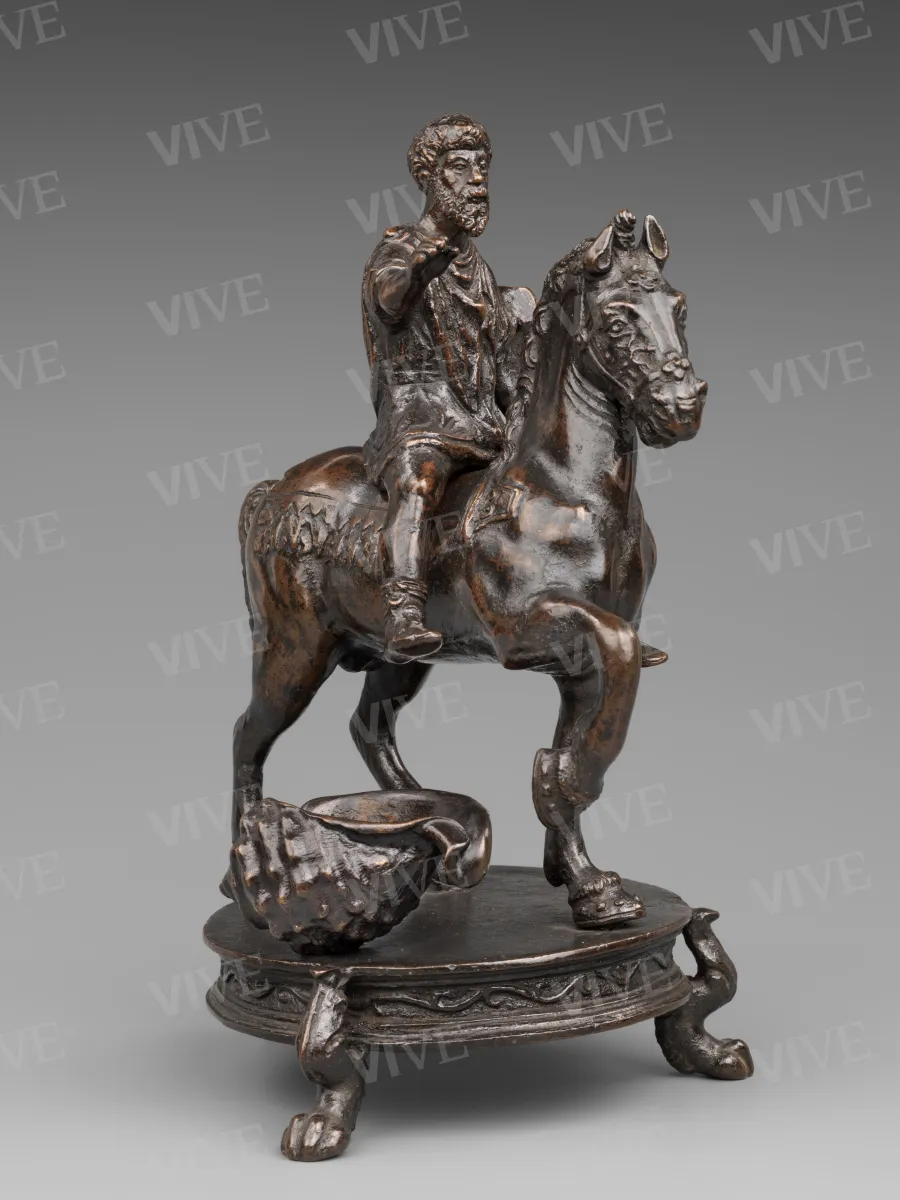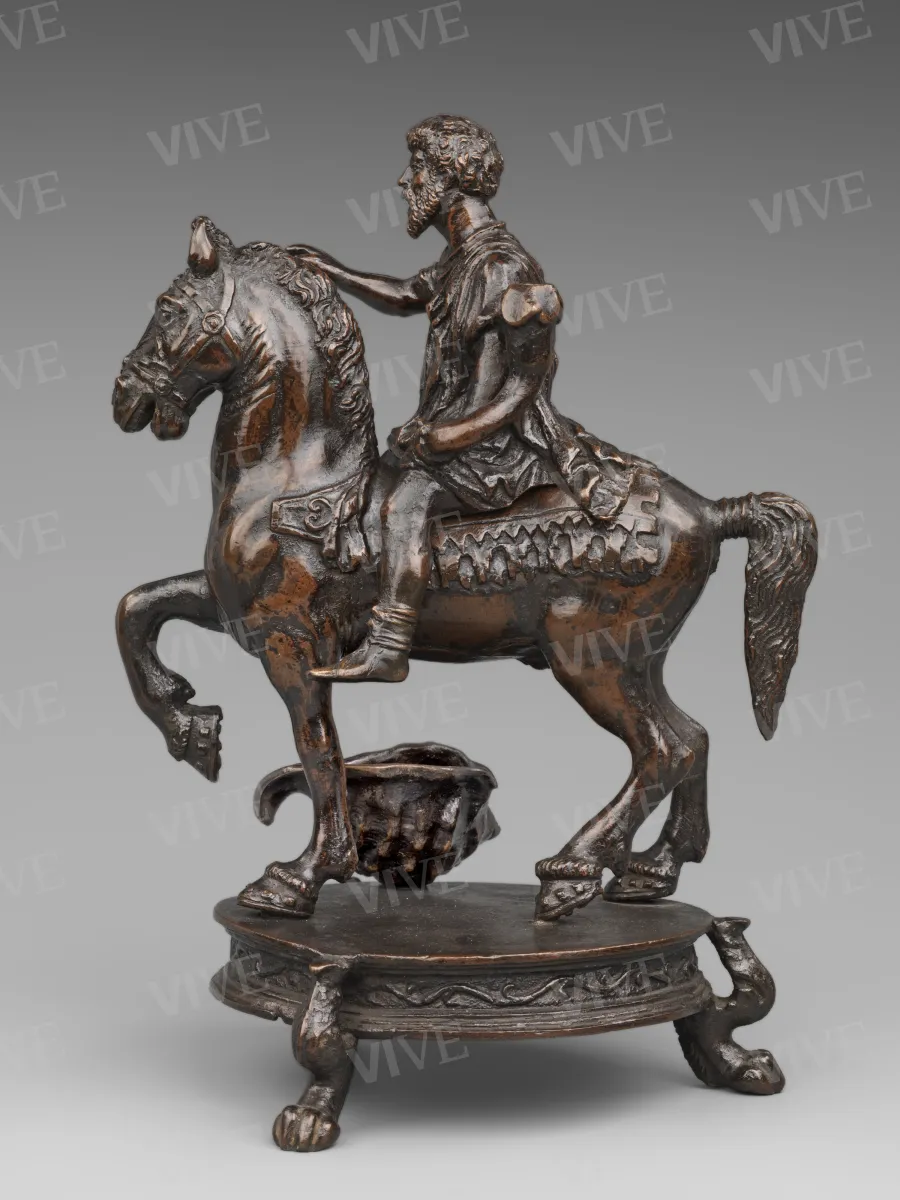Marcus Aurelius Inkwell
Workshop of Severo Calzetta da Ravenna C. 1510–1530 (the model)
According to a typical Renaissance logic of private appropriation of the ancient Roman world, this small bronze sculpture adapts the well-known equestrian statue of Emperor Marcus Aurelius into a functional inkwell for a writing desk: the shell was designed to hold ink, while the cornucopia in the knight’s left hand held the pen nib. The creation of this prototype is credited to Severo Calzetta da Ravenna, a notable bronze artist of the sixteenth century in northern Italy.
According to a typical Renaissance logic of private appropriation of the ancient Roman world, this small bronze sculpture adapts the well-known equestrian statue of Emperor Marcus Aurelius into a functional inkwell for a writing desk: the shell was designed to hold ink, while the cornucopia in the knight’s left hand held the pen nib. The creation of this prototype is credited to Severo Calzetta da Ravenna, a notable bronze artist of the sixteenth century in northern Italy.
Details of work
Catalog entry
The small bronze sculpture depicts a harnessed horse in motion, accompanied by a bearded figure attired in Roman clothing. This individual is dressed in a short tunic with a paludamentum fastened on his right shoulder via a fibula and wears refined sandals known as “calcei patricii.” His right arm extends forward while his left arm, positioned along his side, holds a cornucopia, which likely originally functioned as a pen holder. Adjacent to this ensemble is a shell serving as an inkwell; it was possibly added later to replace the original, according to Pietro Cannata (Cannata 2011, 61–62, cat. 59). The entire group is mounted on a circular base adorned with vine tendrils and supported by lion’s paws. This bronze is a scaled-down reproduction of the renowned equestrian statue of Emperor Marcus Aurelius in Rome (Sommella, Parisi Presicce 1997, 36–41).
There are at least twenty examples similar to the one under examination, characterized by minor variations in the shape of the cornucopia, the inkwell, the base, and the corbels. Notable examples include the piece formerly part of the Spitzer collection (La collection Spitzer 1890–1892, IV, 113, cat. 10), the specimen housed in the Museo Nazionale di Ravenna (Martini 1985, 74–75, cat. 6), and the item recently auctioned at Sotheby’s (Master Paintings and Sculpture Day Sale 2018, 198, cat. 264).
There have been numerous conflicting opinions regarding the origin of the variants: some critics attribute their invention to Bartolomeo Bellano, others to Andrea Briosco, known as il Riccio, and still others to Bertoldo di Giovanni (Goldschmidt 1914; Bardini 1918, cat. 97; Townsend 1920, cat. 287; von Bode 1930). Some scholars prefer a more general attribution to a workshop in Padua or one active in northern Italy at the beginning of the sixteenth century (Pollak 1922, 56, n. 39; Balogh 1966, 279; Gramaccini 1985, 356–357, cat. 55–57). However, the attribution that is currently more broadly accepted by experts is that proposed by Patrick De Winter, who suggested Severo Calzetta da Ravenna (De Winter 1986, 101–102). Indeed, Marcus Aurelius exhibits the typical characteristics of the Ravenna master’s style, such as powerful musculature, drapery composed of thick, intricate folds of fabric, and beard and hair finished curl by curl. Furthermore, the proliferation of examples with varying results in terms of quality, compositional modifications, and adaptations to meet diverse customer demands is a distinctive feature of Severo’s workshop.
Calzetta’s invention, likely created in the 1510s or 1520s, reflects the Renaissance practice of private appropriation of the ancient world. Specifically, it is an item for a study, designed to be held and observed from all angles.
The equestrian monument, during the workshop’s serial production process which continued for over seventy years following the master's death, was eventually altered. It was reduced not only in size but also in its grandeur, becoming a utilitarian object equipped with an inkwell and pen holder. According to Gramaccini, this attenuation is due to the popular medieval legend of the “great farmer” who recognized in the knight of the Roman monument not the emperor but a simple farmer who had managed to stop an invasion of barbarians. Additionally, Severo may have taken inspiration from the ancient equestrian monument in Pavia known as Regisole, which, according to sources from Ravenna, was preserved in the Romagna city during the Middle Ages. Evidence suggests that this monument appeared considerably less dramatic and solemn compared to the statue of Marcus Aurelius located on the Capitoline Hill today (Gramaccini 1985, 64–69).
Marco Scansani
Entry published on 12 June 2025
State of conservation
Good.
Provenance
Rome, Collezione Alfredo Barsanti, 1934;
Rome, Museo Nazionale di Palazzo Venezia, 1934.
References
La collection Spitzer: Antiquité, Moyen Age, Renaissance, 6 voll., London 1890-1892;
Goldschmidt Fritz, Königliche Museen zu Berlin: Beschreibung der Bildwerke der christlichen Epochen. Die italienischen Bronzen der Renaissance und des Barock: Büsten, Statuetten und Gebrauchsgegenstände, Berlin 1914;
Bardini, in De Luxe Illustrated Catalogue of the Beautiful Treasures and Antiquities Illustrating the Golden Age of Italian Art Belonging to the Famous Expert and Antiquarian Signor Stefano Bardini of Florence: New York 23-27 April 1918, Anderson Galleries, New York 1918;
Townsend, in De Luxe Catalogue of the Rare Artistic Properties Collected by Raoul Tolentino: New York, 21-27 April 1920, Anderson Galleries, New York 1920;
Pollak Ludwig, Raccolta Alfredo Barsanti, Roma 1922;
von Bode Wilhelm, Staatliche Museen zu Berlin, Bildwerke des Kaiser-Friedrich-Museums. Die italienischen Bildwerke der Renaissance und des Barock. Zweiter Band. Bronzestatuetten. Büste und Gebrauchsgegenstände, Berlin 1930;
Balogh Jolán, Studi sulla collezione di sculture del Museo di belle arti di Budapest, in «Acta historiae artium Academiae Scientiarum Hungaricae Magyar Tudományos Akadémia», XII, 1966, pp. 211-346;
Gramaccini Norberto, Die Umwertung der Antike: zur Rezeption des Marc Aurel in Mittelalter und Renaissance, in Beck Herbert, Blume Dieter (a cura di), Natur und Antike in der Renaissance, catalogo della mostra (Francoforte sul Meno, Liebieghaus, 5 dicembre 1985-2 marzo 1986), Frankfurt am Main 1985, pp. 51-83;
Martini Luciana (a cura di), Piccoli bronzi e placchette del Museo Nazionale di Ravenna, Ravenna 1985;
De Winter Patrick, Recent Accessions of Italian Renaissance Decorative Arts, Incorporating Notes on the Sculptor Severo da Ravenna, in «The Bulletin of the Cleveland Museum of Art», LXXIII, 1986, pp. 75-138;
Sommella Anna, Parisi Presicce Claudio, Il Marco Aurelio e la sua copia, Cinisello Balsamo 1997;
Cannata Pietro, Museo Nazionale del Palazzo di Venezia. Sculture in bronzo, Roma 2011;
Master Paintings and Sculpture Day Sale: New York, 2nd February 2018, Sotheby’s, New York 2018.














